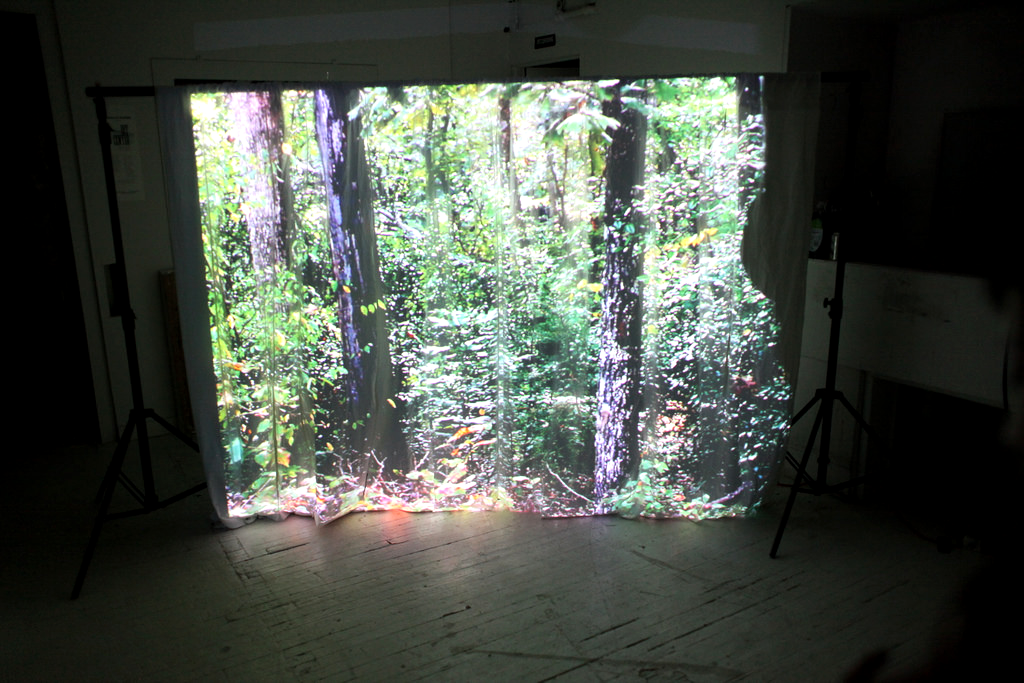
The anxious folks down at the Chicago Art Department (CAD) in Pilsen chose to channel their fear and trembling into something productive this past Friday. The result was “Modern Anxiety,” an exhibition featuring the filmic musings of local artists on their, and our, existential unease.
Jessica Myers, a resident artist at the CAD, curated the show and exhibited two pieces within it. Myers brims with excitement at the prospect of disturbing people with her work. She found inspiration for the show in everyday life; “I started thinking about anxiety as one of the orienting factors of the human condition,” she said. “I think it’s a level that people can relate on.”
Myers curated the show to force visitors to experience anxiety, whether or not they normally have to deal with it. “I’m trying to make people uncomfortable with the installation,” she said.
The films were projected both from the center of the gallery space and from the walls across the room, making it nearly impossible to walk around without blocking one of the movies or getting in the way of other spectators. “People don’t know where to stand, where to orient themselves,” said Myers. “They constantly feel like they’re in someone else’s way.”
At first the effect comes off as a little bit cheap, but over time a certain unease begins to take hold. There is no good place to stand, and the only things to look at are unsettling meditations on the emptiness and stress of modern life.
It is the audio performance, however, that may have sent gallery-goers over the edge. A background track, fraught enough to send David Lynch into a catatonic breakdown, plays over the installation. On a stage above the whole spectacle, guitarists take turns sparring with spectators’ psyches by plucking discordant cords and marrow-synthesizing riffs. “I’m always a little nervous about things,” explained Ian Sutherland, one of the musicians.
The ruminations on disquiet in “Modern Anxiety” ran the gamut from abstract art-house hand-wringers to more concrete mediations on American culture. One featured artist, Lori Felker, woke herself up at three in the morning to film herself speaking about her dreams. The twist is that Felker appears on a CNN-like news set, with a ticker below. As she narrates whatever transpired beyond her mortal coil, images on the screen reflect her dream.
“I love when newscasters show their real personalities,” she said. “I recorded those after the Haitian earthquake, so I would read a ton of news until it seeped into my dreams, so what I’m saying is totally based in reality.”
The effect is unsettling—dream interpretations of the deaths of thousands filter into the spectator’s consciousness. Felker works as an assistant professor at UIC, where she teaches Myers. Myers curates Felker. Fittingly, to access her work, you have to walk through a knot of structural anxiety, ducking behind the exhibition’s bar to make it to the pile of televisions and sound systems that constitute Felker’s installation.
Another film, “Spider” by Melissa Myser, deals with the artist’s anxiety about death. The film features a close shot of a spindling crochet, created by Myser’s grandmother before her recent death. “It’s me trying to describe how she spins these stories and made these worlds, and how sad it was for her to be gone,” Myser said.
Close up, the thread whips and turns furiously, a textile having a panic attack. Knowing that the thread’s maker has since died deepens the scene’s unsettling energy.
Generally, the focus on dissonance can seem like a cop-out. Although the effect really does get under your skin, any kind of error or incongruity can be chalked up to the overall intent of “anxiety.” Beyond that, while the exhibition’s staging certainly does induce anxiety—social and physical—it can feel a little bit forced, and like a distraction from the work itself.
But that kind of dissonance, and the gallery’s perverse will to accept it in all its forms, drags the viewer towards anxiety’s quiet nature. Anxiety doesn’t come from intense focus—it is more consuming and disorienting than that. For some it means an electric overload in the heart, for others a quiet lump in the throat that stops speech, and for others a jittering leg or shaking hand betraying deeper internal chaos. And for Myers and the other folks at CAD, the anxiety won’t go away.
